The next liquidity crisis will likely be spurred by the woes in commercial real estate (CRE); ironically, a four-headed megatrend which has been accelerated by the Fed's rate hike cycle.
Introducing the Four Horsemen of MELA:
- The Great Migration – population shifts to suburbs, rural areas, and the sunbelt;
- The CRE implosion from an oversupply of office space;
- Bullish Supply Dynamics for Homebuilders; and
- The Evolving End of Globalization.
This once-in-a-generation confluence of events has created both opportunities for mega-profits.
The MELA Connection
Bull markets (M) increase the value of 401 (k) plans, IRAs, and trading accounts, creating a positive wealth effect which leads to increased consumer spending, and rallies the economy (E) as bullish consumers make important life decisions--buying homes and cars (L). Wealthy consumers induce bankers to make loans, expanding the virtuous cycle.
Banking decisions are influenced by artificial intelligence fueled formulas which factor in a potential borrower's credit worthiness partially based on the value of stock-based accounts. News travels fast via social media and the news cycle, which are also controlled by algorithms (A). Thus, system-wide moves happen quickly.
Nowhere is this dynamic more evident that in the interplay between CRE and the homebuilder sector. Here is the background:
- The 2008 subprime mortgage crisis made homebuilders wary of overbuilding creating secular supply crunch in residential housing;
- The COVID pandemic spawned the work-from-home megatrend, resulting in glut of commercial office space;
- The lockdowns prompted a population migration to suburbs, rural areas, and other states;
- This ongoing migration has made both the office glut in major cities, as well as the home supply crunch in suburbs, rural areas, and states like Texas, Florida, the Carolinas, and others in the sunbelt, practically permanent;
- Geopolitical changes, spurred by the pandemic and the war in Ukraine have ended the globalization trend, creating an unpredictable future for businesses; and
- The Federal Reserve has been raising interest rates to combat inflation, which is due to structural problems in the U.S. economy caused by globalization and its death pangs.
As the system adjusts, the Great Migration is compounding CRE's problems and resulting in rising joblessness, and a continued limited supply of residential housing. As globalization sputters, this four-headed megatrend and its accompanying structural inflation shows no sign of ending anytime soon.
That means the Fed is odds on to raise rates after its May 2-3 FOMC meeting.
Empty Buildings Don't Produce Rental Income
The bellwether for CRE's woes is the ongoing implosion of co-working company WeWork (WE). Built on the principle that wide open work spaces catering to free-lancers and part-time workers would flourish as the gig economy expanded, the company flourished in its early days.
As the dynamic boomed, WE leased large spaces in prominent buildings in large cities, financing its ambitious plans with adjustable debt. When the pandemic struck, everything fell apart, as work-from-home made co-working spaces obsolete. The company is now reeling and may be on the verge of bankruptcy.
As I described here, the amount of cash on WEs, would only cover 14.5% of its debt load. In addition, the New York Stock Exchange has notified the company that its stock will be delisted within six months due to its low price. WE is walking away from leases and facing law suits from land lords.
Refinancing of adjustable debt at higher interest rates, combined with fewer tenants, reduced revenues forcing the company to default on its rent obligations. The price chart needs no explanation.
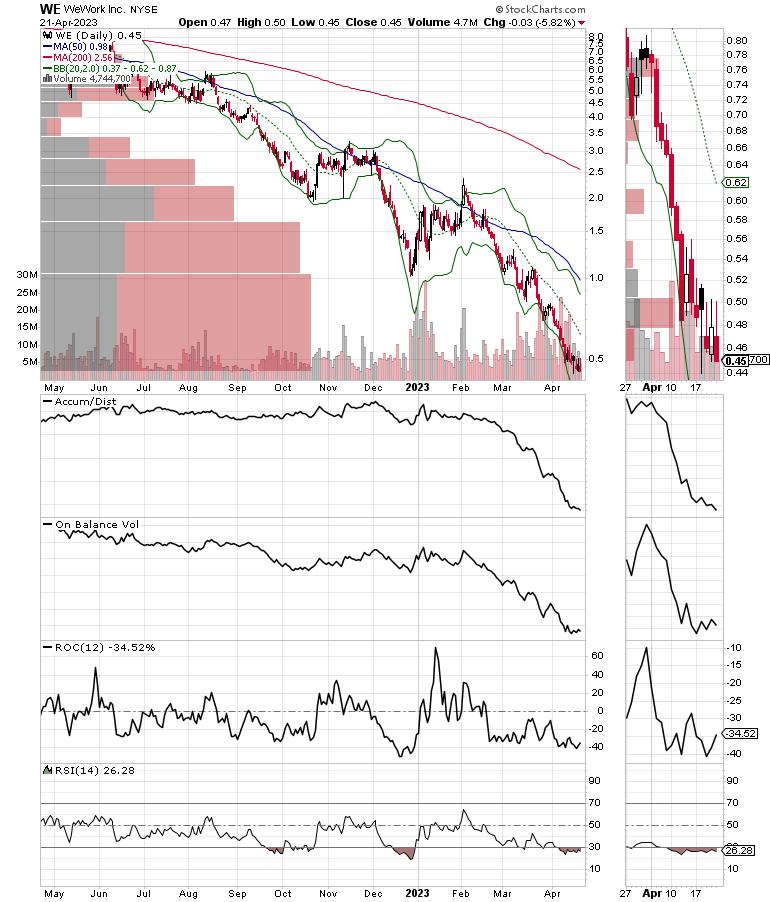
WE is not alone. For example, even CRE giant Blackstone Group (BX) is having problems, as a Korean investor, Inmark Asset Management, looks to unload $50 million worth of Blackstone's mortgage debt in fears of a potential default by Blackstone on the debt. See details on this developing story here.
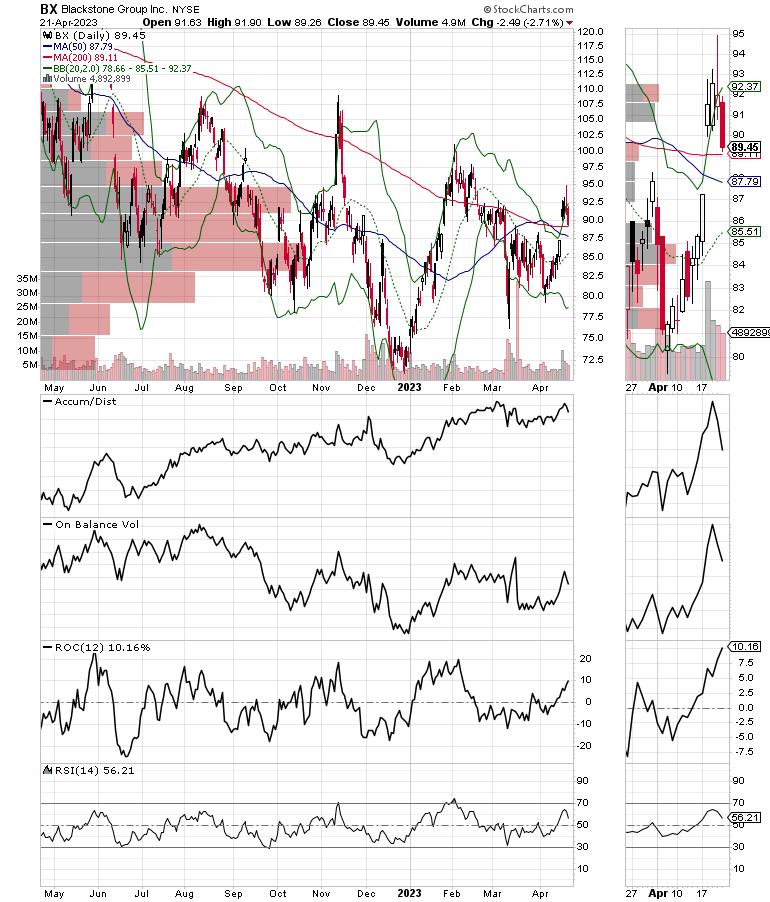
Blackstone, because of its much deeper pockets, is faring better than WeWork. But even though it met its most recent earnings expectations, the shares seem to have run into a brick wall as they reached the $95 area. You can see that's where a large Volume by Price bar (VBP) is offering what looks to be stout price resistance. If BX shares break below their 200-day moving average, they could move back toward their recent lows.
There is an easy way to protect your portfolio against what may be very nasty breakdown in CRE. You can access this simple tool with a FREE trial to my service. Click here for more information.
Horton Blows Out Earnings Expectations
Shares of homebuilder D.R. Horton (DHI) broke out on 4/20/23 after an earnings beat, even as results were lower than the previous year's results.
Nevertheless, due to supply being in its favor, DHI is selling houses at higher prices while smartly not overbuilding and focusing on areas of the country with growing populations. Here are some details:
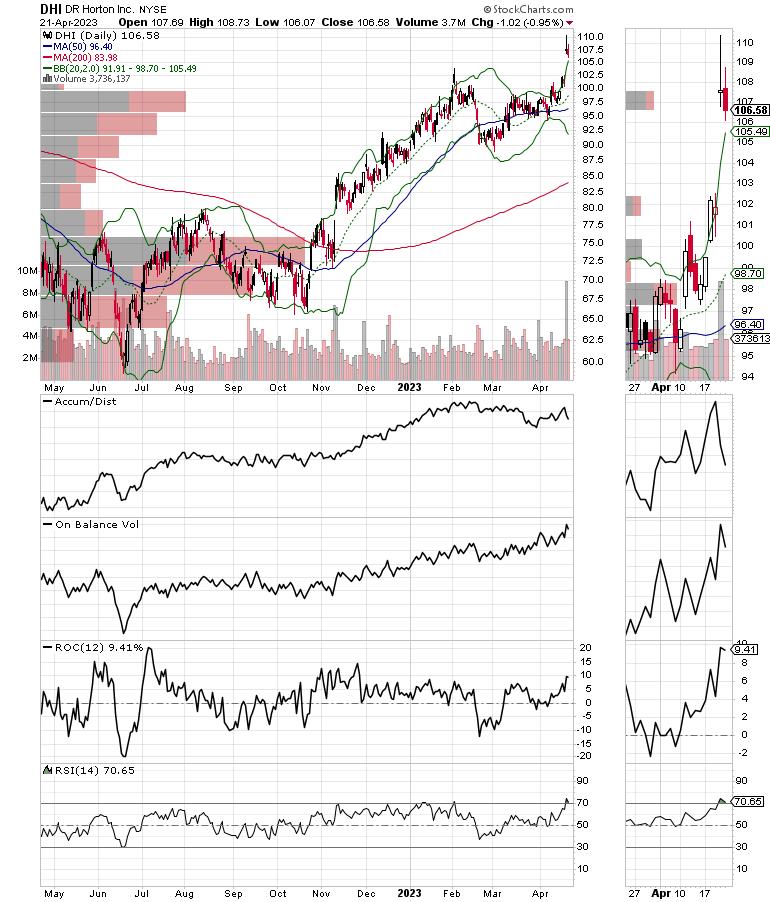
Connecting the dots: The Great Migration to the sunbelt and tight home supplies are keeping DHI in the money. Sales and revenues have slowed thanks due to higher interest rates. Moreover, the lack of apartment sales suggests that the CRE situation is getting worse, as real estate investment trusts have no money to spend and are not investing in new properties. This will most likely result in a continuation of the current state of supply and demand in affordable housing.
To view my homebuilder picks and how I'm trading the commercial real estate market, click here. I own shares in DHI.
Bonds and Mortgages Rise Slightly. Expect Panic Buyers to Materialize
D.R. Horton's Q2 earnings illustrate two simple principles: 1) Low housing supply is bullish for homebuilders, and 2) When mortgage rates fall, potential buyers come into the market. Moreover, when rates dip for a short period and then start to rise, on-the-fence buyers jump in as they fear missing out. We're about to see more of that.
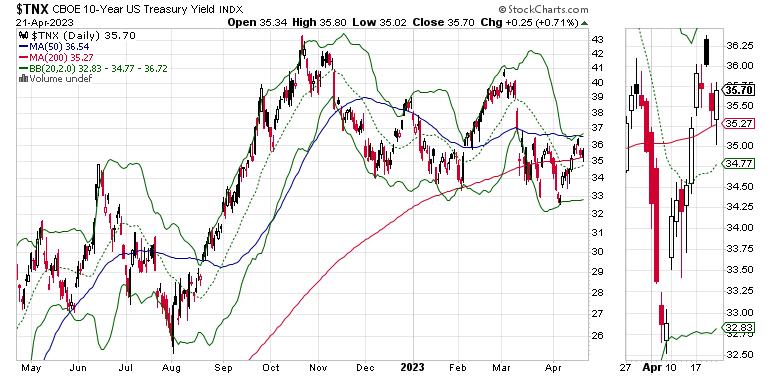
The Fed's warnings about another rate hike in May have pushed the U.S. Ten Year Note (TNX) above the 3.5% yield area. This resulted in a rise of the 30-year mortgage to 6.4%.
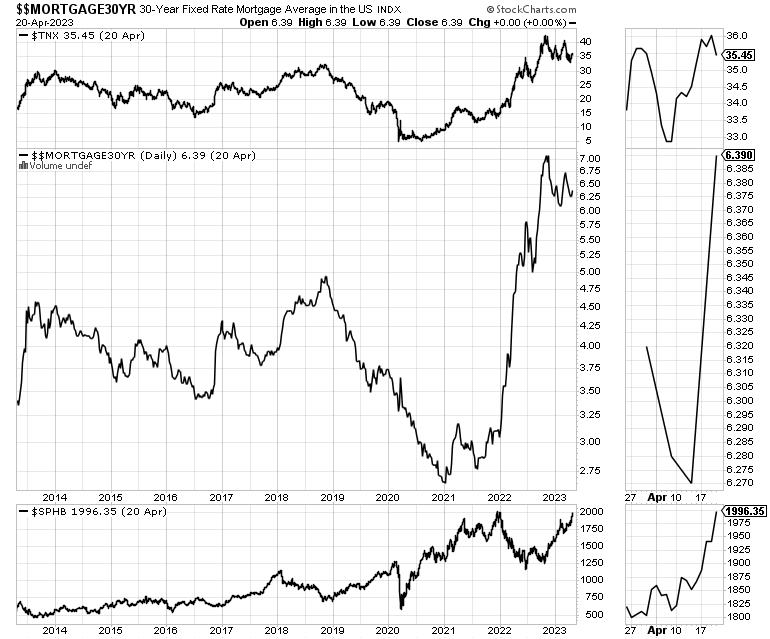
The long-term connection between TNX, mortgage rates and the homebuilder sector (SPHB) is well established. For an in-depth comprehensive outlook on the homebuilder sector, click here.
Breadth Rolls Over. Nasdaq 100 Barely Holds 13,000
The trading range in the major indexes continues, but the market's breadth had a bad week as the New York Stock Exchange Advance Decline line (NYAD) rolled over. NYAD still closed above its 20- and 50-day moving averages, but it did show some weakness.
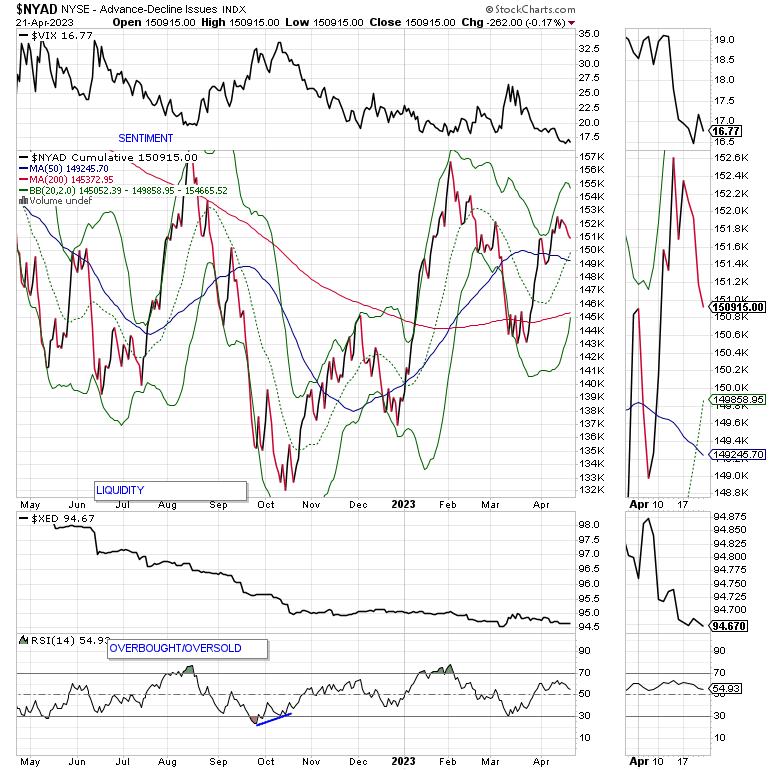
The S&P 500 (SPX) remained above 4100. 4200 is still an a key resistance level. On Balance Volume (OBV) and Accumulation Distribution (ADI) remained constructive.
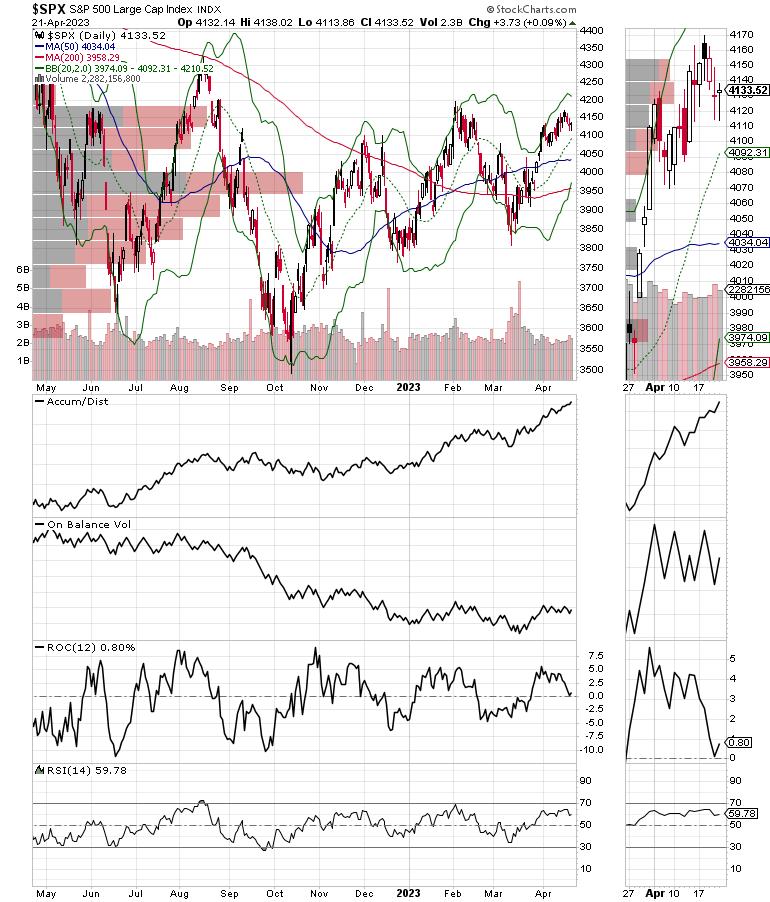
The Nasdaq 100 Index (NDX) barely held above 13,000, which has becomes fairly reliable support. This remains bullish, as it suggests money is now pouring into technology stocks. When tech stocks rally, the give the whole market a boost. Accumulation Distribution (ADI) and On Balance Volume (OBV) are very bullish for NDX.
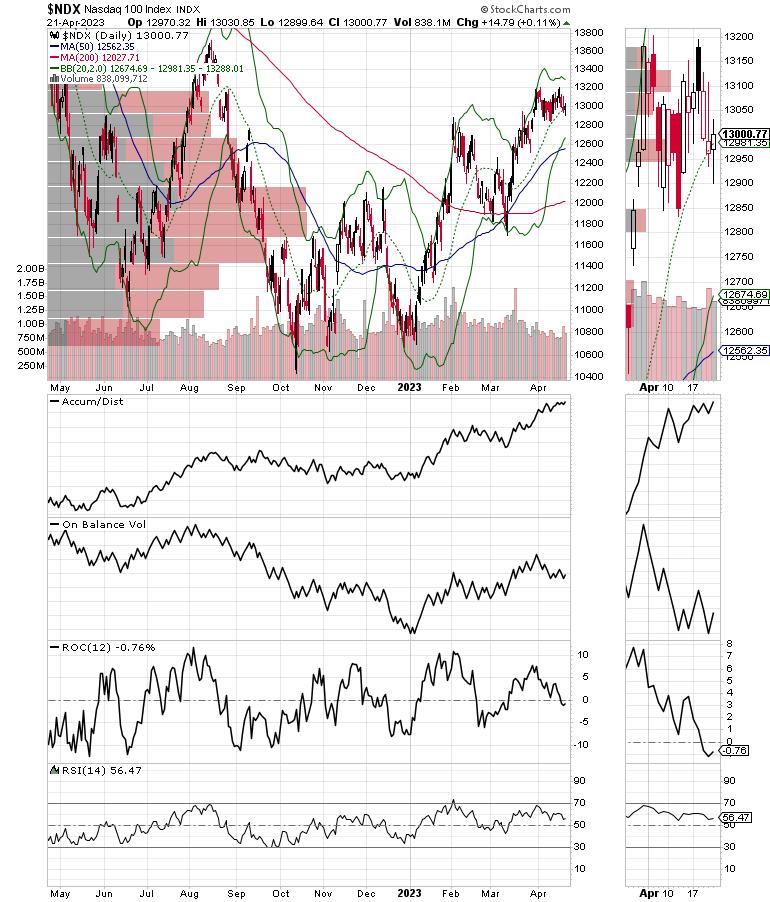
The CBOE Volatility Index (VIX) broke to a new low and is now well below 20, a sign that the bears are throwing in the towel. This is also bullish.
When VIX rises, stocks tend to fall, as rising put volume is a sign that market makers are selling stock index futures in order to hedge their put sales to the public. A fall in VIX is bullish, as it means less put option buying, and it eventually leads to call buying, which causes market makers to hedge by buying stock index futures. This raises the odds of higher stock prices.
The market's liquidity retreated as the Eurodollar Index (XED) closed slightly below 94.75 on Fed hike expectations. A move above 95 will be a bullish development for sure. Usually, a stable or rising XED is very bullish for stocks. On the other hand, in the current environment, it's more of a sign that fear is rising and investors are raising cash.
To get the latest up-to-date information on options trading, check out Options Trading for Dummies, now in its 4th Edition—Get Your Copy Now! Now also available in Audible audiobook format!
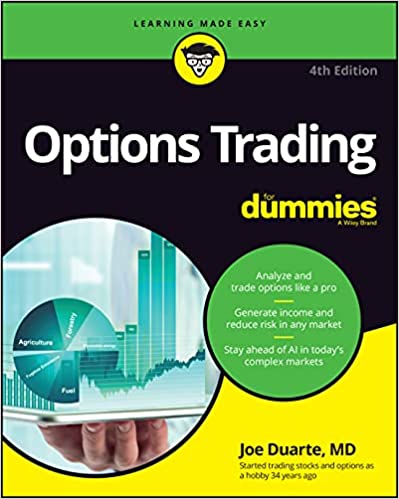 #1 New Release on Options Trading!
#1 New Release on Options Trading!
Good news! I've made my NYAD-Complexity - Chaos chart (featured on my YD5 videos) and a few other favorites public. You can find them here.
Joe Duarte
In The Money Options
Joe Duarte is a former money manager, an active trader, and a widely recognized independent stock market analyst since 1987. He is author of eight investment books, including the best-selling Trading Options for Dummies, rated a TOP Options Book for 2018 by Benzinga.com and now in its third edition, plus The Everything Investing in Your 20s and 30s Book and six other trading books.
The Everything Investing in Your 20s and 30s Book is available at Amazon and Barnes and Noble. It has also been recommended as a Washington Post Color of Money Book of the Month.
To receive Joe's exclusive stock, option and ETF recommendations, in your mailbox every week visit https://joeduarteinthemoneyoptions.com/secure/order_email.asp.
